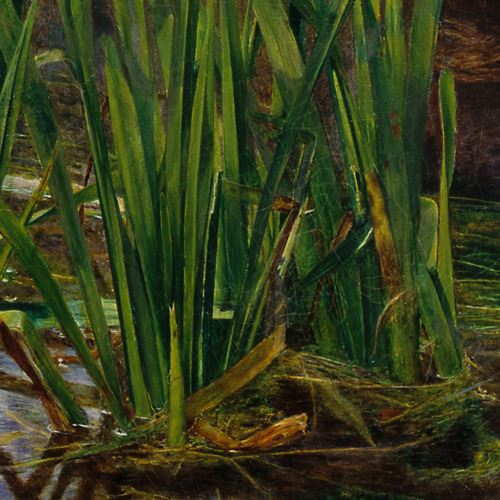lilly-laudanum-leviosaa: preraphaelist:preraphaelist:hidden details in millais’ ophelia:&n
lilly-laudanum-leviosaa: preraphaelist: preraphaelist: hidden details in millais’ ophelia: a robin perched on a branch in the upper right hand corner. a mist of cobweb above the sitter’s feet ominously remminiscent of a skull. dead reeds rotting in the water. the backdrop was in 1851 from june until november, in ewell, surrey. a garland of violets around the neck of ophelia, modelled by elizabeth siddal. painting the backdrop for ophelia was a rather disastrous affair, as it was frequently too wet to work. millais painted for eleven hours a day when he was able; he wrote of the affair to a friend that he sat “…under an umbrella throwing a shadow scarcely larger than a halfpenny…“, was threatened by the local village magistrate for ‘destroying’ a hayfield, threatened again by a bull romping through said hayfield, and was”…also in danger of being blown by the wind into the water, and becoming intimate with the feelings of Ophelia when that lady sank to muddy death… There are two swans who not a little add to my misery by persisting in watching me from the exact spot I wish to paint, occasionally destroying every water-weed within their reach. Certainly the painting of a picture under such circumstances would be a greater punishment to a murderer than hanging.” ^^ not only that, the painting had tragic consequences on elizabeth siddal’s (the model) real life. typically posing for her lover, the famous rosetti, on this occasion he “lent her out” as he frequently did to his fellow pre-raphaelite brothers, she layed fully clothed in a bath to emulate the floating in water, staying there so long that the water had gone cold, she came out with an acute case of hypothermia or pneumonia, one of the two, this lead to her doctor prescribing opium to which she would become heavily addicted to, the eventually was an overdose at home alone when rosetti was out. her demise shattered him as a man, he would call 3 different doctors before accepting her fate. broken rosetti burried her with his poems, when suffering writers block years later he reluctantly had her exhumed to retrieve this book. according to those present, her pale white skin had been preserved “by the opium” and her red curly hair continued to grow filling the coffin… i think you’ll recognise her from paintings such as beata beatrix and other rosetti/raphaelite pieces, this likely won’t be the last time i post about this tragic and haunting fate thank you for your comments! i hope you don’t mind if i correct some points, as some of this information is more myth than fact. elizabeth siddal was never “lent out” by rossetti. she was entirely in charge of who she sat for. when she modelled for millais, she was not in a relationship with rossetti. their relationship began after the ophelia incident. she did not sit again in a professional capacity after ophelia because of her ill health and because she desired to be an artist rather than a model. she was exceptionally talented and became rossetti’s student. pre-eminent art critic john ruskin was her patron for a period of time. the bathtub in millais’ studio was lit by oil lamps which went out: millais was obsessive, and siddal feared to disturb him, so she allowed the water to go cold. it is unknown how serious the sickness she developed after this incident actually was: we do know it was not acute and likely not hypothermia, as the doctor’s bill- which the siddals had millais pay- was not high enough to suggest a prolonged serious illness. scholars are ultimately unsure whether siddal’s later ill health was the aftereffects of the bathtub incident, tuberculosis, an intestine disorder, a psychosomatic illness in response to the infidelities of her lover/mentor rossetti (he had multiple affairs during their relationship), anorexia nervosa, or something else entirely. she was not prescribed opium in response to the bathtub incident, but several years later because of her poor health. prior to and during her addiction, she was prolific artist and poet in her own right, but her illness became so severe after 1860- in coincidence with her marriage to rossetti- that she ceased working.her death was a suicide induced by purposeful overdose of laudanum. again, the cause of her suicide is unknown, as the note she left was burned by rossetti to protect her reputation. it is believed she suffered from severe depression, likely exacerbated by ill health and rossetti’s behaviour. there is no real evidence whatsoever she was preserved in her coffin. rossetti himself was not present at the exhumation, instead choosing to send a close friend, charles howell, who reported and purported the legend of her preservation. it is believed he reported this in an effort to soothe rossetti’s guilt over siddal’s suicide, for which he felt responsible. -- source link
Tumblr Blog : preraphaelist.tumblr.com
#elizabeth siddal



